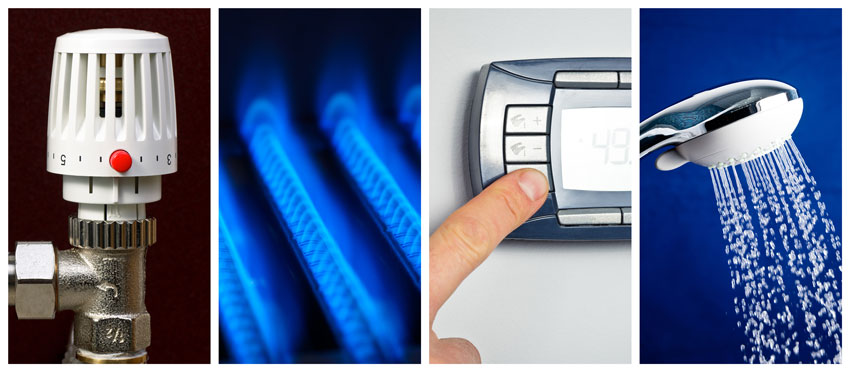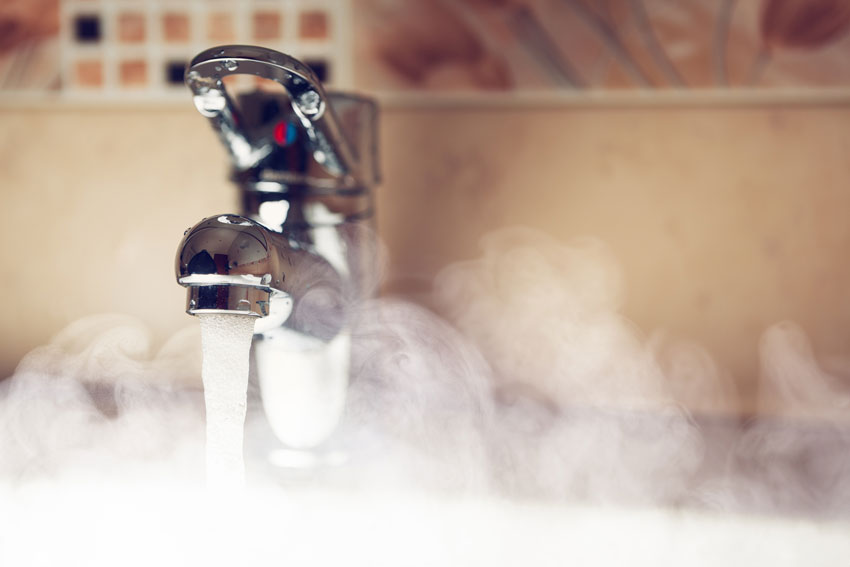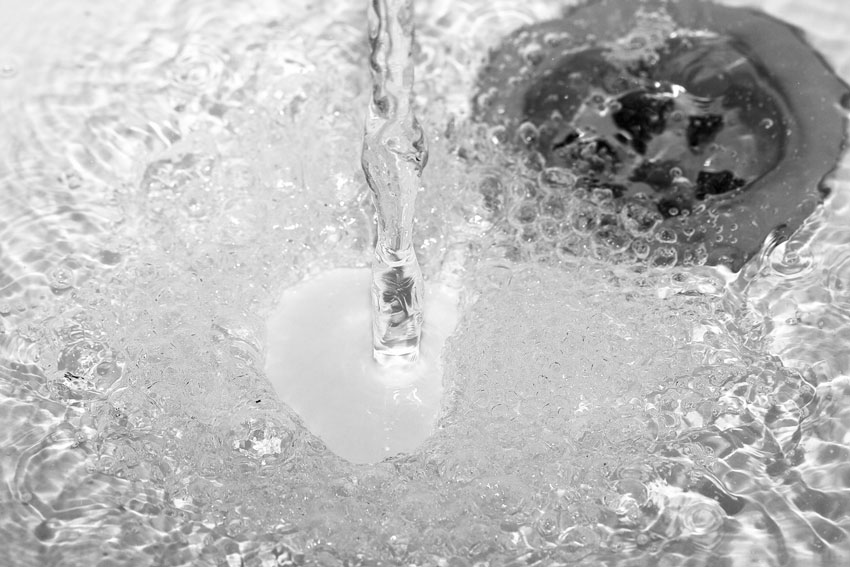Solutions to Help Control Legionella
Solution 1: Heating of Water
Facilities that provide hot water throughout the building can consider this solution as part of their overall WMP. It can be very effective because legionella bacteria are very sensitive to heat. The normal temperature range for legionella bacteria to grow is between 68–122 degrees Fahrenheit. At temperatures below 68 degrees Fahrenheit, it becomes dormant, and at elevated temperatures, it will die. Part of the concern is that the ideal growth range is between 95–115 degrees Fahrenheit, which is the typical operating temperature of many hot water heating systems. Hence, a WMP that seeks to use heat as a treatment solution needs to have the capability to do so but without the fear of scalding and compromising the safety of people in the building.
The premise of a heat solution is that legionella die within 5–6 hours in water heated above 131 degrees Fahrenheit, and more rapidly at higher temperatures. Once the potential sources of water contamination are identified (i.e., storage tanks or other components), then the temperatures there need to be aligned to assure bacteria does not grow. The most straightforward approach here is for the daily water temperature in a system to be kept above 131 degrees Fahrenheit to kill any bacteria. ASHRAE 188 recommends 140 degrees Fahrenheit as the baseline temperature in this case to kill the bacteria within 30 minutes. In the case of a discovered contamination of the water, the temperature can be raised briefly to around 160 degrees Fahrenheit for a high-temperature flush of the system. This will rapidly kill all of the bacteria in the heated water system and eliminate the threat of a pending outbreak.

Heating water to a designated temperature can keep legionella bacteria from spreading or rapidly kill it off in the event of an outbreak.
One of the design considerations of a heating solution is the layout of the piping. If water is being circulated throughout the system and heated at a central source, then there needs to be some certainty that all of the water is actually making it to that heat source so it can be appropriately heated. Remote portions of the piping, sometimes referred to as dead legs, may create pockets of water that does not fully circulate. That means any water that may sit there for some time is not treated. In those cases, either the dead legs need to be eliminated from the design if possible, or a point-of-use solution needs to be incorporated as a supplement to the central heating.
The pros of using heating to control legionella include the very effective and ASHRAE 188 recommended way that it can kill bacteria in a matter of minutes to purge a system, with obvious applicability only to the heated water portion of a plumbing system. The cons include the need to address any dead legs, provide safety against scalding, and the potential of wasting water during a full system flush. Fortunately, all of these cons can be addressed and overcome.
Addressing Hot Water Safety
While heating water daily to 140 degrees Fahrenheit (or during an incident up into the rapid kill range) is one of the most effective and reliable control measures for dealing with legionella, it is not necessarily the best temperature for heated water to be used by people. On average, any water that is above 106 degrees Fahrenheit will cause scalding and pain in humans, while water that is 140 degrees Fahrenheit can cause third-degree burns in a matter of seconds. This is why plumbing codes limit the maximum temperature exiting a fixture at 120 degrees with the expectation that people can readily control the mix of cold and hot water at the faucet to meet their needs. The solution to this competing set of interests is found in the use of tempering valves or mixing valves that blend hot water (generated and stored at temperatures high enough to kill bacteria) with cold water in a controlled manner. This ensures constant, safe outlet temperatures while minimizing the occurrences of both scalding and legionella.

Scalding from hot water is a legitimate safety concern that needs to be addressed as part of a total plumbing solution that may include mixing valves and a digital control system.
When looking at mixing valve systems, there are two fundamental types. A point-of-source (POS) system locates valves at or near the water heating source and typically has a higher capacity for controlled temperature water. A point-of-use (POU) system uses multiple, smaller mixing valves at or near plumbing fixtures such as showers, lavatories, whirlpools, and emergency fixtures. Both types are common and have a range of standards issued by the American Society of Sanitary Engineers (ASSE) relevant to particular usage.
Beyond purely mechanical mixing valves, computerized digital mixing systems are also available that are considered a smarter and safer way to deliver mixed water throughout a health-care facility. In this type of system, intelligent control modules and electronically actuated valves are used to allow faster and more accurate response to constant changes in the mixed-water delivery demands, often anticipating system changes before they occur. Further, digital water mixing and recirculation solutions can be integrated into a building automation system to allow facility managers complete control of and visibility into their domestic hot water delivery.
As a point-of-source system, certain digital mixing and recirculation stations can provide precise control of hot water delivery within 2 degrees of the set point, surpassing industry standards for mechanical systems. When coupled with point-of-use solutions they can help mitigate any potential issue from dead legs in the system. Either way, digital mixing eliminates temperature creep within the system, thus eliminating the need for balancing valves. All of this means that it can more precisely be controlled to mitigate legionella growth in the heated water. In particular, a sanitization or disinfectant mode can be triggered to briefly raise the temperature above 158 degrees Fahrenheit to induce a “rapid kill” and purge all legionella bacteria. At the same time, the digital mixing system can control temperatures leading to faucets, showers, etc. to reduce the risk of scalding in the mixed water. If combined with separate point-of-use protection, then it allows for continuous elevated circulation temperatures to prevent legionella per ASHRAE & CDC guidelines. Concurrently, the digital system can control the circulation pump to prevent stagnant conditions or maximize flow rates. Finally, since most large facilities use some type of building automation system, a digital mixing system can be linked to the larger system to communicate and control temperature, pressure, flow, and energy consumption as part of an overall operations and maintenance plan. It also makes documentation and verification more straightforward in a water management program as called for in ASHRAE 188. From a specification standpoint, most of these systems are easy to install since they typically come pre-piped, pre-wired, and tested.
Solution 2: Chlorination and Hyper-Chlorination
The solution of adding chlorine to water is common to control not just legionella but also other bacteria. It is well suited for portions of water systems where hot water is not normally used, such as pools, decorative fountains, drinking fountains, etc. But since it is typically a point-of-source solution, it will treat and kill bacterial in all water regardless of temperature. Chlorination of drinking water is routine for municipal water supplies intent on addressing a wide range of bacteria, but at the facility level, there may be a need to alter the chlorine level to assure healthy water quality. This requires a process of on-site chlorination and the associated equipment, chemicals, and personnel to go along with it.

Chlorination of water is common but carries some legitimate concerns regarding health effects and corrosion to the plumbing system.
If chlorine is being added to the water, then it is very important to control and monitor the amount being used, particularly if the water is already being received with chlorine in it. Too much can be harmful to people, while too little may not disinfect the water, causing potential bacteria outbreaks. To assist in the control and monitoring, there are systems available that inject chlorine at controlled rates for regular daily use. These systems require human oversight but can otherwise be fairly automated based on water flow. In the case of an outbreak or if any other concern does arise, then “hyper-chlorination” has been employed as a short-term, high-level corrective measure. This raises the amount of chlorine in the water to between 10 and 15 milligrams per liter, which is much higher than the typical recommended levels of 0.5 to 2 milligrams per liter for daily use. At these higher concentrations, bathing in the water or drinking it is not recommended, as it may cause skin irritation or rashes. Note that some water supplies use a variation on chlorine known as mono-chloramine that can cause some poor after effects on the taste and smell of the water after hyper-chlorination. Hence, lower levels of added chlorine are called for in this case. Either way, after this hyper-chlorination shock to the system the water needs to be flushed out and replaced with fresh water.
There are some effects on the plumbing system from hyper-chlorination too. Any level over 5 milligrams per liter turns the water acidic, which makes it more corrosive to pipes, joints, fittings, and fixtures. If chemical flushing is used with hyper-chlorination, the effects could be more pronounced since chemical flushing can expose metal surfaces, making them more susceptible to chlorine damage. In addition, chlorine is an excellent electrical conductor, which is significant in plumbing systems that have mixed metals in them (common in older buildings). Chlorine passing over these various metals can create an electrical charge that produces galvanic corrosion of the piping and releases metals into the water supply. The results of these chemical interactions is that piping can begin to wear and leak at joints and connections. That means they can cause significant damage not only to the water system but also to the building. The only solution is to replace water piping that is typically embedded in walls, floors, ceilings, etc., which is clearly a large and often unanticipated expense.
The pros of chlorination include the relative ease of implementing it and a general applicability to both hot and cold water systems. The cons, however, can be numerous. High concentrations can cause unpleasing odors and taste as well as human health reactions (rash, skin irritation, potential carcinogen). Further, high concentrations have not proven to be consistently effective at killing legionella. Separate from human concerns, it can also be harmful to plumbing systems in that corrosion and pin-hole leaks have been known to develop over time. And, if the chlorine is being added on a regular basis, then such a system will require some amount of floor space to store bulk chlorine. All of this reveals hyper-chlorination to be one of the most unreliable yet one of the most expensive solutions for water treatment.










